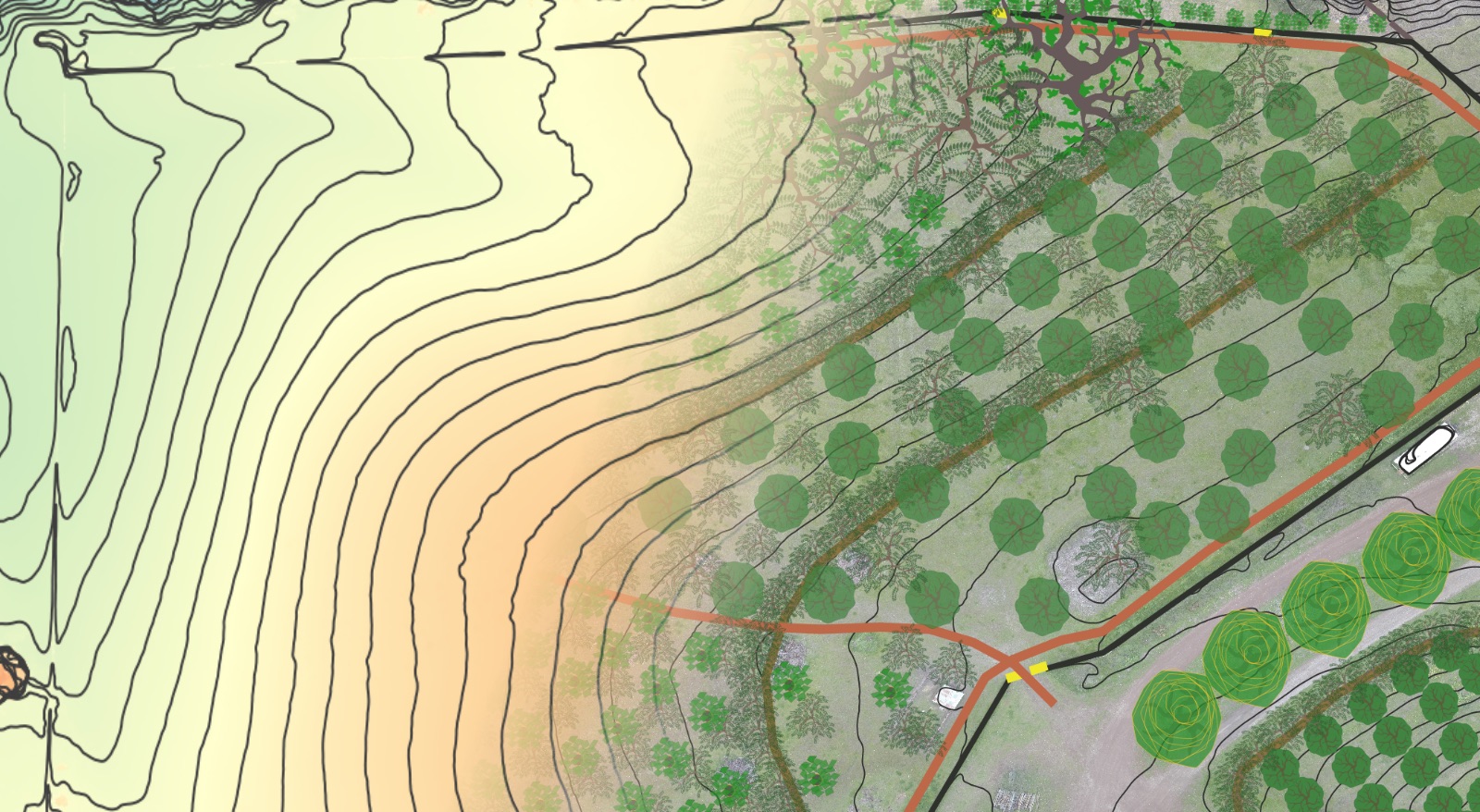
Holistic Ecosystem Design
Client Vision And Goals: To create a resilient refuge for family and close friends in a beautiful wilderness area with regenerative systems for providing food and water security indefinitely. The ranch is to be developed as an eventual full time home for multiple generations of the family, with a focus on creating a place where all can come as they are and be together in fellowship, focused on shared values and leaving pre-conceptions at the front gate.

Existing Conditions / Design Map


Design Elements
- Water
- Dryland watershed management strategies and techniques for improving overall hydration of the landscape and thus its food production potential, including strategically located swales, infiltration basins, and leaky weirs to harvest water from existing road surfaces, and contour felling for fire mitigation and water infiltration.
- Revamped and newly designed drainage infrastructure (rolling dips, media lunas, stone lines on contour) to support site-wide hydration and perennial growing systems while eliminating existing road erosion.
- Increased water storage capacity utilizing both closed (tanks) and open storages (ponds) for animal and crop production and self-reliant back ups.
- Gravity-powered water filtration system for grid-independent water purification.
- Access
- Vehicle access improvements to establish vehicle access along the creek, along the center ridge crest in the lower third of the property, and to reduce mud and rut formation in the most frequently trafficked areas.
- Fencing recommendations for livestock management, tree establishment and livestock protection.
- Structures
- Residential retrofits and additions, including outdoor kitchens for improved air quality and decreased cooling costs, regenerative firescaping to enhance fire survivability, and greywater optimizations to grow deciduous shade trees at strategic positions around residential structures to increase their energy efficiency and habitability.
- Outbuilding recommendations including shop placement and orientation without sacrificing prime growing areas.
- Animal and plant shelter recommendations for montane dryland climates, including a 4-season climate battery greenhouse, Korean Natural Farming no-smell poultry coop, and earth bermed animal shelters.
- Living Systems
- Highest ROI soil fertility enhancing systems, including site-specific methods of nutrient cycling and cultivation of indigenous micro-organisms for use in growing soils and livestock systems.
- Nutrient cycling systems including vermicompost, biochar and compost tea to improve sharply draining, low-nutrient soils for year round growing and increased frost resistance.
- Utilizing Korean Natural Farming techniques to create no-smell confinement animal and poultry pens.
- Biogas as a solid waste treatment alternative to traditional septic and leach fields, with the gas used to heat hot water for the occupied dwellings.
- Context-appropriate food production systems and management strategies including adaptive management of small ruminant livestock (goats) on the upland chaparral slopes, dryland silvopasture for enhanced forage availability, poultry, bees, perennial greenhouse growing systems and wicking beds focused on a largely animal-based diet.
- Biological erosion control in incised drainages using live staked willows and one rock dams to enhance soil hydration and increase available forage resources.
- Screen plantings to mitigate dust from road surfaces that also produce food and provide valuable habitat. Regenerative firebreaks.
- Shade tree species recommendations and planting locations around frequently inhabited structures and zones to reduce heat gain and cooling costs while expanding usable indoor/outdoor space around each dwelling.
- Highest ROI soil fertility enhancing systems, including site-specific methods of nutrient cycling and cultivation of indigenous micro-organisms for use in growing soils and livestock systems.
- Energy
- Recommended systems, design patterns, and retrofits for grid-independent space heating and cooling, including passive solar design strategies, rocket mass heaters, earth tubes and solar chimneys.
- Gravity-powered, low head, variable flow water pumping systems from on and off-property water sources.
Zones 1 & 2: Existing Conditions / Design Map


Passive Water Harvesting Elements


